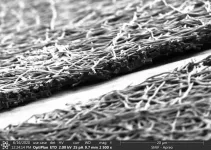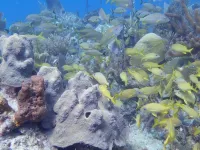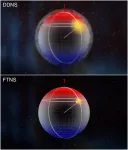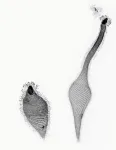(Press-News.org) Restricting menthol flavor in cigarettes while making nicotine replacement therapy, such as a skin patch that can help ease withdrawal, more available and affordable has the potential to reduce socioeconomic disparities in tobacco use.
That was one of the findings in a study published in May in Nicotine and Tobacco Research that marks a new use of existing data from the Fralin Biomedical Research Institute at VTC’s Addiction Recovery Research Center. Researchers analyzed data from their Experimental Tobacco Marketplace to look beyond broad effects of tax and regulatory policies for the journal’s special issue on the health equity effects of restricting flavored nicotine.
Cigarette smoking is the leading cause of preventable death in the U.S., according to the Centers for Disease Control and Prevention. Smoking also accounts for more than 30 percent of the difference in life expectancy among socioeconomic groups, according to the study’s lead author, Assistant Professor Roberta Freitas-Lemos.
The tobacco industry has more heavily marketed flavored tobacco products, such as menthol cigarettes, in communities with lower household incomes and educational attainment.
Freitas-Lemos said the team saw an opportunity to use the marketplace to extend the Fralin Biomedical Research Institute’s work in addressing equity and inclusion in health research.
“We realized we could use an existing data set, split the sample in two based on socioeconomic status, and compare how policies implemented affected purchase behaviors of different groups,” she said. “The study has shown us that flavor restrictions may decrease tobacco-related disease and death rates.” It also points to the need to evaluate tobacco restrictions in a broader context, as cigarette substitution is highly dependent on what other products are available.
In the Experimental Tobacco Marketplace, study participants use an online account to purchase tobacco and nicotine products based on their reported use. Researchers adjust the product mix and pricing to predict their effects on purchase behavior. The marketplace applies the economic concept of substitution effect, in which decreased sales of a product can be attributed to purchasers switching to alternatives as prices rise.
"We came up with a methodology, endowed it with an Amazon-like interface, and we give study participants an amount to spend based on their reported use,” said Warren Bickel, professor with the Fralin Biomedical Research Institute and director of the Addiction Recovery Research Center. “In the process, we’re understanding how new policies may change consumers’ behavior.”
What’s critical, he said, is understanding the interplay of policies. “We’ve shown there’s a policy that ameliorates disparity, but if you implement a second, different policy simultaneously, it destroys that effect,” Bickel said. “We think this is an exciting outcome. If we can actually start addressing and forecasting the impact of policy on health disparity, that’s a game-changer.”
Bickel also is director of the institute’s Center for Health Behaviors Research and a psychology professor with Virginia Tech’s College of Science. Freitas-Lemos also is assistant professor in the College of Science and is part of the Fralin Biomedical Research Institute's Center for Health Behaviors Research and Cancer Research Center.
In addition to Freitas-Lemos and Bickel, Fralin Biomedical Research Institute authors on the study include Research Assistant Professor Allison Tegge and Assistant Professor Jeffrey Stein.
The research is supported by the National Cancer Institute of the National Institutes of Health. “This elegant work by Dr. Freitas-Lemos, Dr. Bickel, and their colleagues spans behavioral neuroscience and tax policy. It represents an emerging area of importance in cancer research that is becoming a major area of emphasis at the National Cancer Institute,” said Michael Friedlander, Virginia Tech’s vice president for health sciences and technology and executive director of the Fralin Biomedical Research Institute. “We are very fortunate to have such an array of talent among our research community that is poised to move the needle in this important new focus for both initial cancer prevention and relapse.”
The team focused on data that simulated the effects of a menthol cigarette ban and a flavored electronic cigarette ban on study subjects based on education and income levels. The analysis examined four conditions: one that mirrored the current market environment, one that imposed only menthol cigarette ban, one that imposed only e-cigarette flavor restrictions, and one that restricted both menthol cigarettes and flavored e-cigarettes.
Researchers saw significant differences under the one that mirrored the current market: Participants in the high socioeconomic status group purchased fewer cigarettes, more e-cigarettes, and more nicotine replacement therapy. The lower-status group purchased more cigarettes, fewer e-cigarettes, and fewer replacement-therapy products. Researchers speculate that menthol allows users to inhale more deeply, potentially allowing smokers with restricted resources to optimize their nicotine intake.
The main finding was that a menthol cigarette flavor ban only significantly decreased disparities with the group with lower socioeconomic status purchasing fewer cigarettes and more nicotine replacement therapy than the group with higher socioeconomic status.
They also found that flavor restrictions lessened differences between the groups’ purchases of nicotine replacement therapy.
The journal’s special issue inspired the current research, but the team has been looking for opportunities to extend a health equity lens to the experimental marketplace.
“We see the prevalence of cigarette use decreasing in the United States, but the disparities are increasing,” Lemos said. “Having an experimental model that can investigate that is important to the field of tobacco research.”
END
Flavor restrictions affect tobacco buyers differently depending on socioeconomic status, researchers say
Public policies intended to reduce harm might perpetuate health disparities in cigarette smoking, Fralin Biomedical Research Institute scientists find
2024-06-06
ELSE PRESS RELEASES FROM THIS DATE:
Botanists and archaeologists receive National Science Foundation grant to study Mediterranean history
2024-06-06
It’s an unusual collaboration. Botanists and archaeologists don’t often work together, unless they’re studying the way people have used plants through time. But a new four-year grant from the National Science Foundation is shaking things up. It provides more than $1 million to study how Mediterranean plants that people have largely ignored evolved and diversified in one of the most formative periods of human history.
“The Mediterranean is at the crossroads of Europe,” said Nicolas Gauthier, curator ...
Silkworms help grow better organ-like tissues in labs
2024-06-06
DURHAM, N.C. -- Biomedical engineers at Duke University have developed a silk-based, ultrathin membrane that can be used in organ-on-a-chip models to better mimic the natural environment of cells and tissues within the body. When used in a kidney organ-on-a-chip platform, the membrane helped tissues grow to recreate the functionality of both healthy and diseased kidneys.
By allowing the cells to grow closer together, this new membrane helps researchers to better control the growth and function of the key cells and tissues of any organ, enabling them to more accurately model a wide range of diseases and test therapeutics.
The research appears June 4 in the journal Science Advances.
Often ...
Scientists ‘read’ the messages in chemical clues left by coral reef inhabitants
2024-06-06
What species live in this coral reef, and are they healthy? Chemical clues emitted by marine organisms might hold that information. But in underwater environments, invisible compounds create a complex “soup” that is hard for scientists to decipher. Now, researchers in ACS’ Journal of Proteome Research have demonstrated a way to extract and identify these indicator compounds in seawater. They found metabolites previously undetected on reefs, including three that may represent different reef organisms.
Plants and animals living in coral reefs release various substances, from complex macromolecules to individual amino acids, into the surrounding water. To determine ...
Identifying risk factors for native coronary atherosclerosis progression after percutaneous coronary intervention
2024-06-06
https://www.scienceopen.com/hosted-document?doi=10.15212/CVIA.2024.0033
Announcing a new article publication for Cardiovascular Innovations and Applications journal. This study was aimed at investigating factors influencing the progression of native coronary atherosclerosis after percutaneous coronary intervention (PCI).
A cohort of 462 patients was classified into progressive (n = 73) or non-progressive (n = 389) groups according to the presence of native coronary atherosclerosis progression on coronary angiography. ...
Mapping noise to improve quantum measurements
2024-06-06
One of the biggest challenges in quantum technology and quantum sensing is “noise”–seemingly random environmental disturbances that can disrupt the delicate quantum states of qubits, the fundamental units of quantum information. Looking deeper at this issue, JILA Associate Fellow and University of Colorado Boulder Physics Assistant Professor Shuo Sun recently collaborated with Andrés Montoya-Castillo, Assistant Professor of Chemistry, and his team to develop a new method for better understanding and controlling this noise, potentially paving the way for significant advancements in quantum computing, ...
Tiny predator owes its shape-shifting ability to “origami-like” cellular architecture
2024-06-06
For a tiny hunter of the microbial world that relies on extending its neck up to 30 times its body length to release its deadly attack, intricate origami-like cellular geometry is key. This geometry enables the rapid hyperextensibility of the neck-like protrusion, for single-celled predator Lacrymaria olor, a new study reports. The findings not only explain L. olor’s extreme shape-shifting ability but also hold potential for inspiring innovations in soft-matter engineering or the design of robotic systems. Single-celled protists are well known for their ability to perform dynamic morphological changes in ...
Widespread use of high-assay low-enriched uranium raises significant nuclear security concerns
2024-06-06
In a Policy Forum, R. Scott Kemp and colleagues argue that promoting new nuclear reactor technologies using high-assay low-enriched uranium (HALEU) threatens the international system of controls that has prevented nuclear weapons proliferation for over 30 years. “Governments and others promoting the use of HALEU have not carefully considered the potential proliferation and terrorism risks that the wide adoption of this fuel creates,” write Kemp et al. The authors warn that if HALEU becomes a standard reactor ...
JWST uncovers features of very-low-mass star’s protoplanetary disk that influence planet composition
2024-06-06
James Webb Space Telescope (JWST) observations have revealed abundant hydrocarbons in the protoplanetary disk surrounding a young, very-low-mass star – findings that provide novel insights into the chemical environment from which many terrestrial planets, in particular, are born. Planets form in disks of gas and dust that orbit young stars. Observations show that terrestrial planets form more efficiently than gas giant planets around very-low-mass stars (VLMSs) – those with less than 0.3 solar masses. Although the chemical compositions of the inner disk regions around higher mass stars ...
Mammalian adipose tissue thermogenesis evolved in eutherian mammals
2024-06-06
Heat production in fat tissue, a trait also known as adipose tissue thermogenesis, evolved over two stages in mammals, fully developing in eutherian mammals after the group’s evolutionary divergence from marsupials, according to a new study. The results could provide insights that inform future therapies related to metabolism and obesity. Many organisms produce heat internally to regulate body temperature. It is thought that the evolution of the ability to maintain high body temperatures provided ...
The first example of cellular origami
2024-06-06
“There are some things in life you can watch and then never unwatch,” said Manu Prakash, associate professor of bioengineering at Stanford University, calling up a video of his latest fascination, the single-cell organism Lacrymaria olor, a free-living protist he stumbled upon playing with his paper Foldscope. “It’s … just … it’s mesmerizing.”
“From the minute Manu showed it to me, I have just been transfixed by this cell,” said Eliott Flaum, a graduate student ...
LAST 30 PRESS RELEASES:
New expert guidance urges caution before surgery for patients with treatment-resistant constipation
Solar hydrogen can now be produced efficiently without the scarce metal platinum
Sleeping in on weekends may help boost teens’ mental health
Study: Teens use cellphones for an hour a day at school
After more than two years of war, Palestinian children are hungry, denied education and “like the living dead”
The untold story of life with Prader-Willi syndrome - according to the siblings who live it
How the parasite that ‘gave up sex’ found more hosts – and why its victory won’t last
When is it time to jump? The boiling frog problem of AI use in physics education
Twitter data reveals partisan divide in understanding why pollen season's getting worse
AI is quick but risky for updating old software
Revolutionizing biosecurity: new multi-omics framework to transform invasive species management
From ancient herb to modern medicine: new review unveils the multi-targeted healing potential of Borago officinalis
Building a global scientific community: Biological Diversity Journal announces dual recruitment of Editorial Board and Youth Editorial Board members
Microbes that break down antibiotics help protect ecosystems under drug pollution
Smart biochar that remembers pollutants offers a new way to clean water and recycle biomass
Rice genes matter more than domestication in shaping plant microbiomes
Ticking time bomb: Some farmers report as many as 70 tick encounters over a 6-month period
Turning garden and crop waste into plastics
Scientists discover ‘platypus galaxies’ in the early universe
Seeing thyroid cancer in a new light: when AI meets label-free imaging in the operating room
Neutrophil-to-lymphocyte ratio may aid risk stratification in depressive disorder
2026 Seismological Society of America Annual Meeting
AI-powered ECG analysis offers promising path for early detection of chronic obstructive pulmonary disease, says Mount Sinai researchers
GIMM uncovers flaws in lab-grown heart cells and paves the way for improved treatments
Cracking the evolutionary code of sleep
Medications could help the aging brain cope with surgery, memory impairment
Back pain linked to worse sleep years later in men over 65, according to study
CDC urges ‘shared decision-making’ on some childhood vaccines; many unclear about what that means
New research finds that an ‘equal treatment’ approach to economic opportunity advertising can backfire
Researchers create shape-shifting, self-navigating microparticles
[Press-News.org] Flavor restrictions affect tobacco buyers differently depending on socioeconomic status, researchers sayPublic policies intended to reduce harm might perpetuate health disparities in cigarette smoking, Fralin Biomedical Research Institute scientists find






